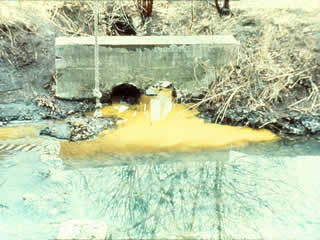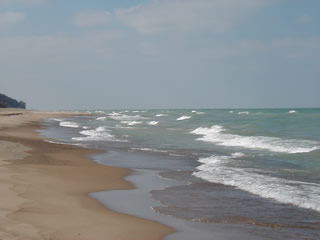|
 Water
Pollution Water
Pollution
Water pollution is "any physical or chemical
change in surface water or groundwater that can harm living
organisms or make water unfit for certain uses" (Miller
G17).
There are two main sources of water pollution,
categorized as point sources and nonpoint
sources. Point source pollution
comes from specific locations, such as through a pipe or a
ditch. Producers of point sources include factories, sewage
treatment plants, and oil tankers. Nonpoint source pollution,
on the other hand, cannot be traced to a specific location.
Nonpoint sources are more dangerous because they are difficult
to contain and research. Examples of nonpoint sources include
acid deposition and chemical
runoff into the surface water.
Pollution of surface and ground water is of
particular concern in Indiana. The state is dependent on surface
and ground water as a source of drinking water. The Indiana
Department of Environmental Management assessed over 99% of
Indiana's rivers and
streams for their ability to support fish, shellfish, and
other aquatic life, and it was found that only 64% of those
waterways were able to completely support all aquatic life.
 |
Lake
Michigan, a popular recreation spot |
In addition, only 59% of 8,660 miles of streams
surveyed were found to be safe for recreation such as swimming
and boating. In over 3,500 stream miles, the amount of E.
coli bacteria signified unsafe recreation levels.
The history of water pollution is difficult
to trace; before the Clean Water Act of 1972, companies indiscriminately
dumped dangerous waste into bodies of water with reckless
abandon. The CWA brought attention to the problems of water
pollution and its effects in the environment. The Safe Drinking
Water Act of 1977 and the Water Quality Act of 1987 strengthened
the Clean Water Act and forced the state of Indiana to clean
up its act and discover ways to make its water safer. Companies
were required to crack down on their own waste disposal and
find safer ways to dispose of dangerous and harmful chemicals.
However, many problems still remain that are
difficult to contain. Water runoff from heavy rains, a type
of nonpoint pollution, can cause sewers to overflow and dump
into lakes and rivers. This same water runoff can carry chemicals
from streets to drinking water sources, polluting our already-threatened
water supply. Animal waste from factory farms
is also a problem; in 1996, the Center for Disease Control
established a link between high nitrate levels in Indiana
drinking water wells located close to feedlots and pregnancy
miscarriages ("Facts about Pollution from Livestock Farms").
Indiana has come a long way in solving many
of the problems of water pollution. The state has implemented
new laws and taken new steps to improve its water quality,
but clean water is still not completely in its grasp.
Sources:
"Facts about Pollution from Livestock
Farms." Clean Water & Oceans: Water Pollution:
In Brief: Fact Sheet. 24 June 2001. Natural Resources
Defense Council. 19 Nov. 2002 <http://www.nrdc.org/water/pollution/ffarms.asp>.
Miller, G. Tyler. Environmental
Science: Working with the Earth. 8th ed. Pacific Grove,
CA: Brooks/Cole, 2001.
"Water Quality." 2002
State of the Environment Report. 2002. Indiana Dept.
of Environmental Management. 16 Oct. 2002 <http://www.in.gov/idem/soe2002/water/>.
Image:
Photo taken by John Craddock
|




